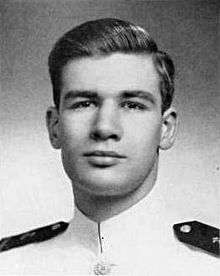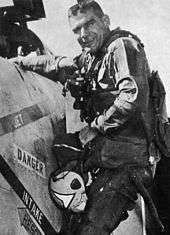Alexander G.B. Grosvenor
| Alexander Graham Bell Grosvenor | |
|---|---|
 Midshipman A.G.B. Grosvenor at graduation from the U.S. Naval Academy | |
| Nickname(s) | Alex, Al |
| Born |
December 7, 1927 Washington, DC |
| Died |
April 7, 1978 (aged 50) Annapolis, Maryland |
| Buried at |
United States Naval Academy Cemetery Annapolis, Maryland, U.S. |
| Allegiance |
|
| Service/branch |
|
| Years of service | 1945–1978 |
| Rank | Captain |
| Battles/wars |
Korean War Vietnam War |
| Spouse(s) | Marcia Bramen Grosvenor |
| Other work | Naval War College |
Alexander Graham Bell Grosvenor (December 7, 1927 – April 7, 1978) was a United States Navy pilot, carrier officer, and avid yachtsman credited with promoting the resurgence of sailing at the United States Naval Academy.[1] He was a great-grandson of the inventor, Alexander Graham Bell, and brother of Gilbert M. Grosvenor, former Chairman of the National Geographic Society.
Early years
Grosvenor was born in 1927, the son of Helen Rowland and Melville Bell Grosvenor, who later became President of the National Geographic Society and Editor of the National Geographic Magazine. In 1937, ten-year-old Alex was present when the Smithsonian Institution's Secretary, Dr. Charles Abbot, opened three boxes of Bell experimental materials that had been kept locked in the Smithsonian's secret archives. In September 1942 Alex enrolled at the Taft School,[2] where he played football and was captain of the wrestling team.[3]
Career
Early
Grosvenor enrolled in the United States Naval Academy in 1945. In the summer of 1947, he sailed with many of his classmates on a Navy training exercise to Europe and subsequently wrote about his experiences in an article entitled "Midshipmen's Cruise" in the June 1948 issue of National Geographic, coauthored with fellow midshipman William J. Aston.[4] Grosvenor sailed the Naval Academy’s Star in the 1949 World Championships in Chicago, and “finished in the top third of the fleet, an accomplishment, which no former Navy Star had come anywhere near,” reported the Star Class Log.[5] He graduated from the Naval Academy in 1950.[6]
Aviation and carrier duty
Grosvenor first served aboard the Saipan-class light aircraft carrier USS Wright (CVL-49) and then served two tours in Korean waters aboard the Essex-class aircraft carriers USS Yorktown (CV-10) and USS Essex (CV-9), piloting the Navy's first swept wing jets.[7] Following a tour as a flight instructor, he served in the Mediterranean aboard the USS Saratoga (CV-60) as aide and flag lieutenant to Commander, Sixth Fleet.

Grosvenor served with Fighter Squadron 21 (VF-21) Freelancers during combat tours in southeast Asia aboard the carriers USS Coral Sea (CV-43) and USS Ranger (CV-61). An F-4B fighter jet flown by Grosvenor when he was Squadron Commander of the Freelancers, now known as "The Midway Phantom," is on display at the San Diego Aircraft Carrier Museum.[8]
After graduating from the Naval War College in 1969,[9] Grosvenor served as Operations Officer of the USS Kitty Hawk (CV-63),[10] and the following year as Executive Officer.[11] In the early 1970s, Grosvenor headed the fighter aircraft test branch at the Naval Air Station Patuxent River.
Naval Academy sailing
In 1973, Grosvenor was appointed commander of the Annapolis Naval Station and commodore of the Naval Academy Sailing Squadron, where he "promoted a resurgence of sailing at the Naval Academy," according to The Washington Post.[12]
"We spent a lot of time upgrading the midshipmen sailing program," recalled Adm. Kinnaird McKee, Superintendent of the Naval Academy at the time, in an interview with the Naval Historical Foundation.[13] "The officer who had that responsibility was Captain Alex Grosvenor (USNA class of ’50). I had sailed in competition with him when I was a plebe and he was a third-classman. He turned our sailing program around. We had been near the bottom in national competition when he arrived – and we won the national championship three years later."
Grosvenor "was instrumental in putting Mids back on blue water," recalls his colleague at the time, Captain Larry Howard, USN(Ret). "In the mid 70's we established an Offshore Division of the Sailing Team that previously was just dinghies and Shields. There is a significant seamanship and leadership impact from training and leading a group of midshipmen on a sailboat offshore. Leadership (as opposed to management) is developed by placing young officers to be in positions where they must make decisions that impact the success (and often safety) of their crew. Offshore sailing is a unique opportunity to provide that experience."[14]
Grosvenor was frequently helped in his sailing duties by his wife, Marcia, who authored a manual on cooking while sailing at sea, Gimbaling Gourmet Galley Guide.
Personal
Grosvenor died from a brain tumor in 1978, and his wife Marcia died in 2002. They were interred at the United States Naval Academy Cemetery, according to Find a Grave, and were survived by two daughters, Pam Mongan Taylor and Sandy Grosvenor, and numerous grandchildren.[15]
Legacy

The A.G.B. Grosvenor Trophy is awarded annually to the volunteer member of the Naval Academy Sailing Squadron who has made exemplary contributions to the mission and programs of the sailing squadron. It was established in 1978 to honor Grosvenor, who had been Commanding Officer, Naval Station Annapolis, and Commodore, Naval Academy Sailing Squadron.[16]
Gallery
-

In 1937, ten-year-old Alex Grosvenor watches as Smithsonian Secretary Dr. Charles Abbot opens three boxes of experimental materials that his great-grandfather, Alexander Graham Bell, had deposited in the Institute's secret archives.
-
_Cruise_Book%2C_1955%2C_Page_156_detail.jpg)
Four Naval aviators onboard the USS Essex in 1955 include LTJG Grosvenor (second from left). From the 1955 Cruise Book of the Essex, page 156.
-
_Cruise_Book_1968_%E2%80%BA_Page_208.jpg)
Squadron Commander Cmdr Alex Grosvenor (above left) and the Squadron's Executive Officer Cmdr J.P. Skyrud were shown with photos of Fighter Squadron VF-21 in the 1968 Cruise Book for USS Ranger on page 208.
-

Photographs of Captain A.G.B. Grosvenor, Executive Officer of the USS Kitty Hawk (CV-63) from its Western Pacific Cruise Yearbook of 1970-1971, page 12.
References
- ↑ "Obituaries: Marcia Braman Grosvenor". The Washington Post. October 23, 2002.
- ↑ "School Welcomes 120 New Boys" (PDF). The Taft Papyrus: 4. September 26, 1942.
- ↑ "Varsity Wrestlers" (PDF). The Taft Papyrus (February 17, 1945).
- ↑ Grosvenor, Alexander G.B. and William J. Aston (June 1948). "Midshipmen's Cruise". National Geographic Magazine (Vol. XCIII, No. 6): 711.
- ↑ Elder, George W. "1949 World's Championship". The Star Log. 1950.
- ↑ Lucky Bag Yearbook. US Naval Academy. 1950. p. 324.
- ↑ USNA Class of 1950. "DECEASED CLASSMATES IN THE YEARS 1970-1979". U.S. Naval Academy.
- ↑ "The Midway Phantom". San Diego Aircraft Carrier Museum.
- ↑ Naval War College. "Graduation Exercises" (PDF) (June 25, 1969).
- ↑ "USS KITTY HAWK (CVA-63) Command History, 1969" (PDF). March 11, 1970.
- ↑ "USS KITTY HAWK (CVA-63) Command History, 1970" (PDF). March 1, 1971.
- ↑ "Obituaries: Marcia Braman Grosvenor". The Washington Post. October 23, 2002.
- ↑ McKee, Adm. Kinnard. "Interview 21 MARCH 2000 (page 67)" (PDF). NavyHistory.org/. Naval Historical Foundation.
- ↑ Howard, Capt. Larry. "Posted 10 April 2008". SailingAnarchy.com.
- ↑ "Obituaries: Marcia Braman Grosvenor". The Washington Post. October 23, 2002.
- ↑ US Naval Academy Sailing Center. "Intercollegiate Intersectional Trophies (under NASS section)". Robert Crown Sailing Center. Retrieved 12 September 2014.
External links
| Wikimedia Commons has media related to Alexander G.B. Grosvenor. |